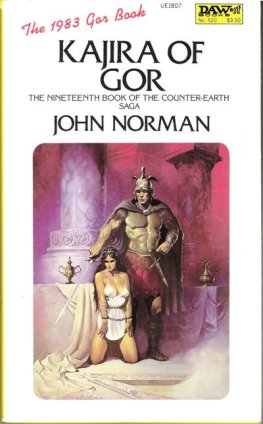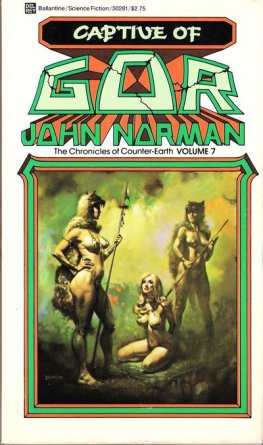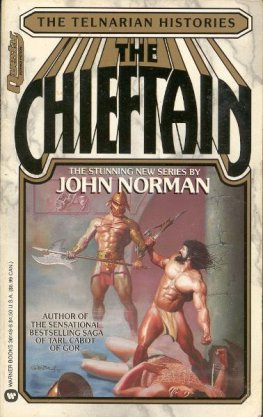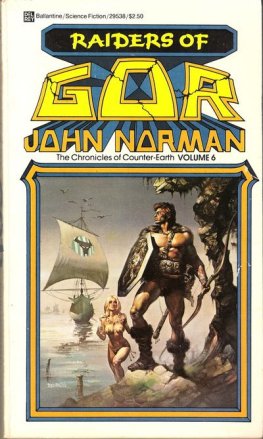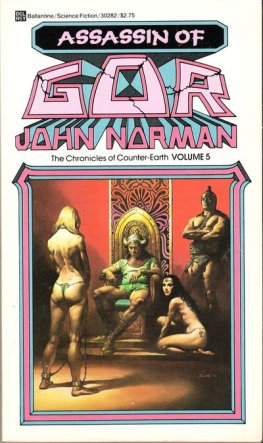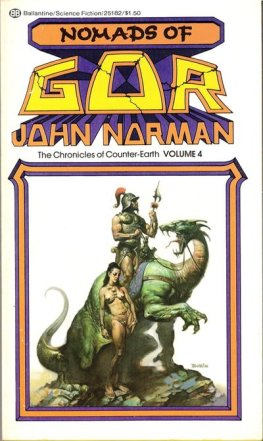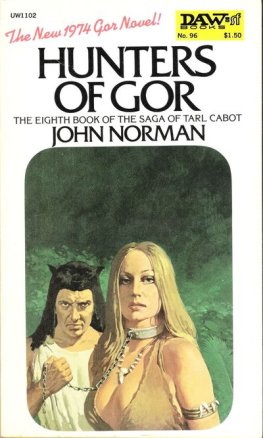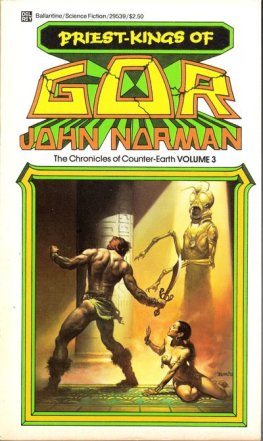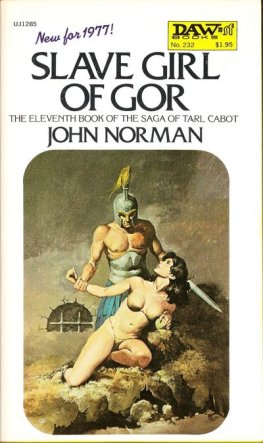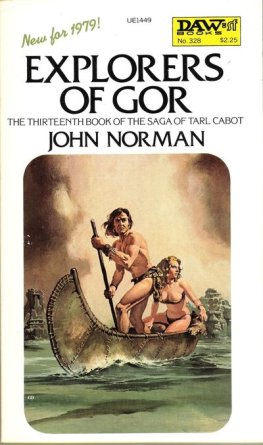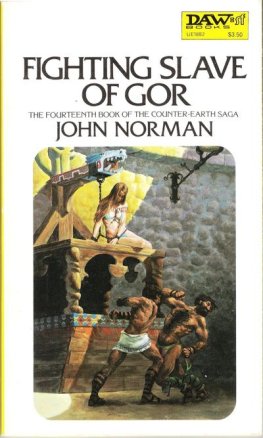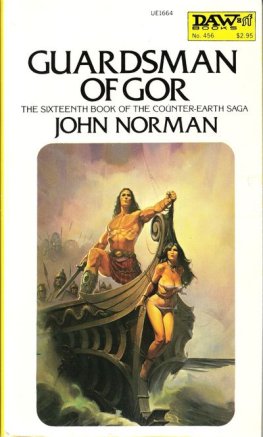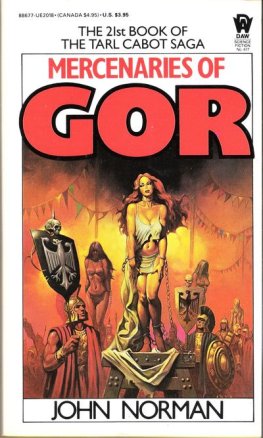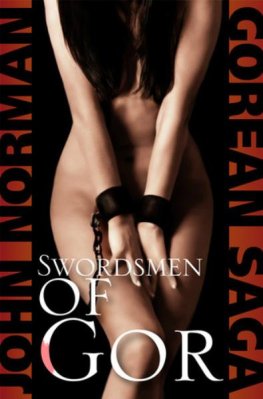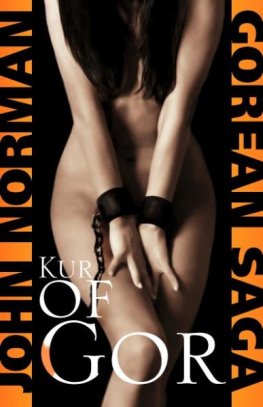KAJIRA OF GOR
(Volume nineteen in the Chronicles of Counter-Earth)
by John Norman
"Do you not see it?" asked the man.
"Yes," said the fellow with him.
"It is incredible," said another.
"The resemblance is truly striking," said the second man.
"Please turn your profile towards us, and lift your chin, Miss Collins," said the first man.
I complied.
I was in a photographer's studio.
"A little higher, Miss Collins," said the first man.
I lifted my chin higher.
"You may change in here," had said the man earlier, indicating a small dressing room off the studio. I had been handed a pair of clogs, a white silk blouse and a pair of black shorts.
"No brassiere or panties," he had said.
I had looked at him.
"We want no lines from them," he said.
"Of course," I had said.
The shorts were quite short, and, even without the panties, at least a size too small. The blouse, too, even without the brassiere, was tight.
"Please tie up the blouse, in front," he said. "We want some midriff." I had complied.
"Higher," he had suggested.
I had complied.
I had then been, to my puzzlement, photographed several times, from the neck up, front view and profile, against a type of chart, on which appeared various graduated lines, presumably some type of calibrating or measuring device. The lines, as nearly as I could determine, however, correlated neither with inches nor centimeters.
"Now, please, step into the sand box," he had said.
I had then stepped onto the sand, in the wide, flat box, with the beach scene projected onto the large screen behind me. Then, for several minutes, the photographer moving about me, swiftly and professionally, sometimes almost intimately close, and giving me commands, the camera clicking, I had been posed in an incredible variety of positions. Men, I had thought, must enjoy putting a woman thus through her paces. Some of the shots were almost naughty. I think, too, given the absence of a brassiere and panties, and the skimpiness and tightness of the shorts, and the tightness of the blouse, doubtlessly calculated features of my apparel, there would be little doubt in the minds of the observers as to the lineaments of my figure. I did not object, however. In fact I rather enjoyed this. I think I am rather pretty.
I was now standing in the sand, my left side facing the men, my chin lifted. The lights were hot. To my left were the lights, the tangles of cord, the men. To my right, in contrast, there seemed the lovely, deserted beach.
"She is pretty," said one of the men.
"She is pretty enough to be a Kajira," said one of the men.
"She will be," laughed another.
I did not understand what they were talking about.
"Do not see such a woman merely in terms of such predictable and luscious commonalities," said the first man.
"You see clearly her potential for us, do you not?"
"Of course," said the second man.
I did not understand them.
"Turn on the fan," said the first man.
I then felt a cool breeze, blown by the large fan in front of me. In the heat of the lights this was welcome.
"This coin, or medal, or whatever it is, is very puzzling," had said the gentle, bespectacled man, holding it by the edges with white, cotton gloves, and then placing it down on the soft felt between us. He was an authenticator, to whom I had been referred by a professional numismatist. His task was not to appraise coins but to render an informed opinion on such matters as their type and origin, where this might be obscure, their grading, in cases where a collaborative opinion might be desired, and their genuineness.
"Is it genuine?" I asked.
"Who sold you this piece," asked the man, "a private party? What did you pay for it?"
"It was given to me," I said, "by a private party."
"That is extremely interesting," said the man.
"Why?" I asked.
"It rules out an obvious hypothesis," said the man. "Yet such a thing would be foolish."
"I do not understand," I said.
"Puzzling," he mused, looking down at the coin on the felt between us, "puzzling."
I regarded him.
"This object," lie said, "has not been struck from machine-engraved dies. Similarly, it is obviously not the result of contemporary minting techniques and technology. It is not the product, for example, of a high-speed, automated coin press."
"I do not understand," I said.
"It has been struck by hand," he said. "Do you see how the design is slightly off center?"
"Yes," I said.
"That is a feature almost invariably present in ancient coins," he said. "The planchet is warmed, to soften the metal. It is then placed between the dies and the die cap is then struck, literally, with a hammer, impressing the design of the obverse and reverse simultaneously into the planchet."
"Then it is an ancient coin?" I asked.
"That seems unlikely," he said. "Yet the techniques used in striking this coin have not been used, as far as I know, for centuries."
"What sort of coin is it?" I asked.
"Too," he said, "note how it is not precision milled. It is not made for stacking, or for storage in rolls."
I looked at him. It did not seem to me he was being too clear with me. He seemed independently fascinated with the object.
"Such coins were too precious perhaps," he said. "A roll of them might be almost inconceivable, particularly in the sense of having many such rolls."
"What sort of coin is it?" I asked.
"You see, however," he asked, "how the depth of the planchet allows a relief and contrast of the design with the background to an extent impossible in a flat, milled coin?"
"Yes," I said.
"What a superb latitude that gives the artist," he said. "It frees him from the limitations of a crude compromise with the counting house, from the contemporary concessions which must be made to economic functionalism. Even then, in so small and common an object, and in so unlikely an object, he can create a work of art."
"Can you identify the coin?" I asked.
"This, in its depth and beauty, reminds me of ancient coins," he said. "They are, in my opinion, the most beautiful and interesting of all coins."
"Is it an ancient coin?" I asked.
"I do not think so," he said.
"What sort of coin is it, then?" I asked.
"Look here," be said. "Do you see how this part of the object, at the edge, seems flatter, or straight, different from the rest of the object's circumference?"
"Yes," I said. To be sure, one had to took closely to see it.
"This object has been clipped, or shaved," he said. "A part of the metal has been cut or trimmed away. "In this fashion, if that is not noted, or the object is not weighed, it might be accepted for, say, a certain face value, the individual- responsible for this meanwhile pocketing the clipped or shaved metal.
If this is done over a period of time, with many coins, of course, the individual could accumulate, in metal value, a value equivalent perhaps to one or more of the original objects."
"Metal value?" I asked.
"In modem coinage," be said, "we often lose track of such things. Yet, if one thinks about it, at least in the case of many coins, a coin is a way in which a government or ruler certifies that a given amount of precious metal is involved in a transaction. It saves weighing and testing each coin. The coin, in a sense, is an object whose worth or weight, in standardized quantities, is certified upon it, and guaranteed, so to speak, by an issuing authority. Commerce as we know it would be impossible, of course, without such, objects, and notes, and credit and such."
"Then the object is a coin?" I said.
"I do not know if it is a coin or not," said the man.
"What else could it be?" I asked.

